[English] 日本語
 Yorodumi
Yorodumi- PDB-7auc: Crystal structure of an engineered helicase domain construct for ... -
+ Open data
Open data
- Basic information
Basic information
| Entry | Database: PDB / ID: 7auc | |||||||||
|---|---|---|---|---|---|---|---|---|---|---|
| Title | Crystal structure of an engineered helicase domain construct for human Bloom syndrome protein (BLM) | |||||||||
 Components Components | Bloom syndrome protein,Bloom syndrome protein | |||||||||
 Keywords Keywords |  NUCLEAR PROTEIN / NUCLEAR PROTEIN /  Helicase / Helicase /  RecQ / BLM / RecQ / BLM /  DNA Repair DNA Repair | |||||||||
| Function / homology |  Function and homology information Function and homology informationregulation of DNA-templated DNA replication / RecQ family helicase-topoisomerase III complex / telomeric G-quadruplex DNA binding / resolution of DNA recombination intermediates / forked DNA-dependent helicase activity / 8-hydroxy-2'-deoxyguanosine DNA binding / DNA/DNA annealing activity / telomeric D-loop binding / telomere maintenance via semi-conservative replication / cellular response to camptothecin ...regulation of DNA-templated DNA replication / RecQ family helicase-topoisomerase III complex / telomeric G-quadruplex DNA binding / resolution of DNA recombination intermediates / forked DNA-dependent helicase activity / 8-hydroxy-2'-deoxyguanosine DNA binding / DNA/DNA annealing activity / telomeric D-loop binding / telomere maintenance via semi-conservative replication / cellular response to camptothecin / G-quadruplex DNA unwinding / t-circle formation / telomeric D-loop disassembly / DNA double-strand break processing / Y-form DNA binding / negative regulation of cell division / DNA 3'-5' helicase / four-way junction helicase activity / G-quadruplex DNA binding / cellular response to hydroxyurea / lateral element / negative regulation of DNA recombination / bubble DNA binding / Processive synthesis on the C-strand of the telomere / Impaired BRCA2 binding to PALB2 / Defective homologous recombination repair (HRR) due to BRCA1 loss of function / Defective HDR through Homologous Recombination Repair (HRR) due to PALB2 loss of BRCA1 binding function / Defective HDR through Homologous Recombination Repair (HRR) due to PALB2 loss of BRCA2/RAD51/RAD51C binding function / Homologous DNA Pairing and Strand Exchange / Resolution of D-loop Structures through Synthesis-Dependent Strand Annealing (SDSA) / 3'-5' DNA helicase activity / Resolution of D-loop Structures through Holliday Junction Intermediates / DNA duplex unwinding / HDR through Single Strand Annealing (SSA) / Impaired BRCA2 binding to RAD51 / nuclear chromosome / DNA unwinding involved in DNA replication / replication fork processing / regulation of cyclin-dependent protein serine/threonine kinase activity / mitotic G2 DNA damage checkpoint signaling / Presynaptic phase of homologous DNA pairing and strand exchange / response to X-ray / ATP-dependent activity, acting on DNA / SUMOylation of DNA damage response and repair proteins / four-way junction DNA binding /  DNA helicase activity / DNA helicase activity /  telomere maintenance / telomere maintenance /  replication fork / molecular function activator activity / replication fork / molecular function activator activity /  helicase activity / cellular response to ionizing radiation / double-strand break repair via homologous recombination / protein homooligomerization / HDR through Homologous Recombination (HRR) / G2/M DNA damage checkpoint / PML body / helicase activity / cellular response to ionizing radiation / double-strand break repair via homologous recombination / protein homooligomerization / HDR through Homologous Recombination (HRR) / G2/M DNA damage checkpoint / PML body /  Meiotic recombination / Meiotic recombination /  nuclear matrix / nuclear matrix /  p53 binding / p53 binding /  single-stranded DNA binding / protein complex oligomerization / single-stranded DNA binding / protein complex oligomerization /  chromosome / Processing of DNA double-strand break ends / DNA recombination / Regulation of TP53 Activity through Phosphorylation / chromosome / Processing of DNA double-strand break ends / DNA recombination / Regulation of TP53 Activity through Phosphorylation /  DNA replication / DNA replication /  DNA repair / DNA damage response / DNA repair / DNA damage response /  nucleolus / positive regulation of DNA-templated transcription / nucleolus / positive regulation of DNA-templated transcription /  ATP hydrolysis activity / protein homodimerization activity / protein-containing complex / ATP hydrolysis activity / protein homodimerization activity / protein-containing complex /  DNA binding / zinc ion binding / DNA binding / zinc ion binding /  nucleoplasm / nucleoplasm /  ATP binding / identical protein binding / ATP binding / identical protein binding /  nucleus / nucleus /  cytosol / cytosol /  cytoplasm cytoplasmSimilarity search - Function | |||||||||
| Biological species |   Homo sapiens (human) Homo sapiens (human) | |||||||||
| Method |  X-RAY DIFFRACTION / X-RAY DIFFRACTION /  SYNCHROTRON / SYNCHROTRON /  MOLECULAR REPLACEMENT / Resolution: 1.53 Å MOLECULAR REPLACEMENT / Resolution: 1.53 Å | |||||||||
 Authors Authors | Chen, X. / Oliver, A.W. | |||||||||
| Funding support |  United Kingdom, 2items United Kingdom, 2items
| |||||||||
 Citation Citation |  Journal: Elife / Year: 2021 Journal: Elife / Year: 2021Title: Uncovering an allosteric mode of action for a selective inhibitor of human Bloom syndrome protein. Authors: Chen, X. / Ali, Y.I. / Fisher, C.E. / Arribas-Bosacoma, R. / Rajasekaran, M.B. / Williams, G. / Walker, S. / Booth, J.R. / Hudson, J.J. / Roe, S.M. / Pearl, L.H. / Ward, S.E. / Pearl, F.M. / Oliver, A.W. #1:  Journal: Biorxiv / Year: 2020 Journal: Biorxiv / Year: 2020Title: Uncovering an allosteric mode of action for a selective inhibitor of human Bloom syndrome protein Authors: Chen, X. / Ali, Y. / Fisher, C.E.L. / Arribas-Bosacoma, R. / Rajasekaran, M.B. / Williams, G. / Walker, S. / Roe, S.M. / Pearl, L.H. / Ward, S.E. / Pearl, F.M.G. / Oliver, A.W. | |||||||||
| History |
|
- Structure visualization
Structure visualization
| Structure viewer | Molecule:  Molmil Molmil Jmol/JSmol Jmol/JSmol |
|---|
- Downloads & links
Downloads & links
- Download
Download
| PDBx/mmCIF format |  7auc.cif.gz 7auc.cif.gz | 130.5 KB | Display |  PDBx/mmCIF format PDBx/mmCIF format |
|---|---|---|---|---|
| PDB format |  pdb7auc.ent.gz pdb7auc.ent.gz | 94.7 KB | Display |  PDB format PDB format |
| PDBx/mmJSON format |  7auc.json.gz 7auc.json.gz | Tree view |  PDBx/mmJSON format PDBx/mmJSON format | |
| Others |  Other downloads Other downloads |
-Validation report
| Arichive directory |  https://data.pdbj.org/pub/pdb/validation_reports/au/7auc https://data.pdbj.org/pub/pdb/validation_reports/au/7auc ftp://data.pdbj.org/pub/pdb/validation_reports/au/7auc ftp://data.pdbj.org/pub/pdb/validation_reports/au/7auc | HTTPS FTP |
|---|
-Related structure data
| Related structure data | 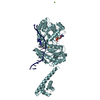 7audC  4o3mS S: Starting model for refinement C: citing same article ( |
|---|---|
| Similar structure data |
- Links
Links
- Assembly
Assembly
| Deposited unit | 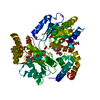
| ||||||||
|---|---|---|---|---|---|---|---|---|---|
| 1 |
| ||||||||
| Unit cell |
|
- Components
Components
-Protein , 1 types, 1 molecules A
| #1: Protein | Mass: 63884.465 Da / Num. of mol.: 1 Source method: isolated from a genetically manipulated source Source: (gene. exp.)   Homo sapiens (human) / Gene: BLM, RECQ2, RECQL3 / Plasmid: pET-17b / Production host: Homo sapiens (human) / Gene: BLM, RECQ2, RECQL3 / Plasmid: pET-17b / Production host:   Escherichia coli BL21(DE3) (bacteria) / References: UniProt: P54132, Escherichia coli BL21(DE3) (bacteria) / References: UniProt: P54132,  DNA helicase DNA helicase |
|---|
-Non-polymers , 9 types, 450 molecules 

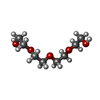














| #2: Chemical | ChemComp-ACT /  Acetate Acetate#3: Chemical | ChemComp-EDO /  Ethylene glycol Ethylene glycol#4: Chemical |  Polyethylene glycol Polyethylene glycol#5: Chemical | ChemComp-GOL / |  Glycerol Glycerol#6: Chemical | ChemComp-ADP / |  Adenosine diphosphate Adenosine diphosphate#7: Chemical | #8: Chemical | ChemComp-ZN / | #9: Chemical | #10: Water | ChemComp-HOH / |  Water Water |
|---|
-Details
| Has ligand of interest | Y |
|---|
-Experimental details
-Experiment
| Experiment | Method:  X-RAY DIFFRACTION / Number of used crystals: 1 X-RAY DIFFRACTION / Number of used crystals: 1 |
|---|
- Sample preparation
Sample preparation
| Crystal | Density Matthews: 2.38 Å3/Da / Density % sol: 48.39 % |
|---|---|
Crystal grow | Temperature: 277.15 K / Method: vapor diffusion, hanging drop / pH: 7.5 Details: Morpheus-HT, condition A8, Molecular Dimensions 0.06 M divalents, 37.5% Buffer System 2 and 37.5% Precipitant Mix 4 Divalents = 0.3M magnesium chloride, 0.3M calcium chloride Buffer system 2 ...Details: Morpheus-HT, condition A8, Molecular Dimensions 0.06 M divalents, 37.5% Buffer System 2 and 37.5% Precipitant Mix 4 Divalents = 0.3M magnesium chloride, 0.3M calcium chloride Buffer system 2 = 1M sodium HEPES, MOPS (acid) pH 7.5 75% Precipitant Mix 4 = 25% w/v MPD, 25% v/v PEG1000, 25% w/v PEG 3350 |
-Data collection
| Diffraction | Mean temperature: 100 K / Serial crystal experiment: N |
|---|---|
| Diffraction source | Source:  SYNCHROTRON / Site: SYNCHROTRON / Site:  Diamond Diamond  / Beamline: I04 / Wavelength: 0.97794 Å / Beamline: I04 / Wavelength: 0.97794 Å |
| Detector | Type: DECTRIS PILATUS3 6M / Detector: PIXEL / Date: May 1, 2016 |
| Radiation | Protocol: SINGLE WAVELENGTH / Monochromatic (M) / Laue (L): M / Scattering type: x-ray |
| Radiation wavelength | Wavelength : 0.97794 Å / Relative weight: 1 : 0.97794 Å / Relative weight: 1 |
| Reflection | Resolution: 1.53→51.23 Å / Num. obs: 88499 / % possible obs: 98.3 % / Redundancy: 1.9 % / Biso Wilson estimate: 32.58 Å2 / CC1/2: 1 / Net I/σ(I): 12.7 |
| Reflection shell | Resolution: 1.53→1.56 Å / Mean I/σ(I) obs: 1.2 / Num. unique obs: 8096 / CC1/2: 0.61 / % possible all: 90.3 |
- Processing
Processing
| Software |
| ||||||||||||||||||||||||||||||||||||||||||||||||||||||||||||||||||
|---|---|---|---|---|---|---|---|---|---|---|---|---|---|---|---|---|---|---|---|---|---|---|---|---|---|---|---|---|---|---|---|---|---|---|---|---|---|---|---|---|---|---|---|---|---|---|---|---|---|---|---|---|---|---|---|---|---|---|---|---|---|---|---|---|---|---|---|
| Refinement | Method to determine structure : :  MOLECULAR REPLACEMENT MOLECULAR REPLACEMENTStarting model: 4O3M Resolution: 1.53→51.23 Å / Cor.coef. Fo:Fc: 0.95 / Cor.coef. Fo:Fc free: 0.94 / SU R Cruickshank DPI: 0.072 / Cross valid method: THROUGHOUT / SU R Blow DPI: 0.074 / SU Rfree Blow DPI: 0.072 / SU Rfree Cruickshank DPI: 0.071
| ||||||||||||||||||||||||||||||||||||||||||||||||||||||||||||||||||
| Displacement parameters | Biso mean: 32.6 Å2
| ||||||||||||||||||||||||||||||||||||||||||||||||||||||||||||||||||
| Refine analyze | Luzzati coordinate error obs: 0.22 Å | ||||||||||||||||||||||||||||||||||||||||||||||||||||||||||||||||||
| Refinement step | Cycle: LAST / Resolution: 1.53→51.23 Å
| ||||||||||||||||||||||||||||||||||||||||||||||||||||||||||||||||||
| Refine LS restraints |
| ||||||||||||||||||||||||||||||||||||||||||||||||||||||||||||||||||
| LS refinement shell | Resolution: 1.53→1.54 Å
|
 Movie
Movie Controller
Controller




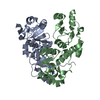
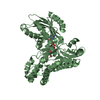
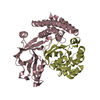
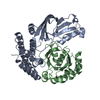
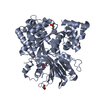
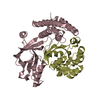
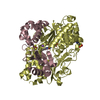
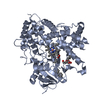
 PDBj
PDBj














